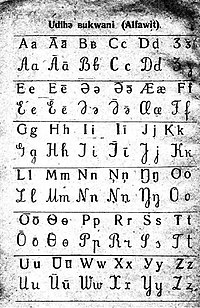Cyrillic alphabets
In the second half of the 1930s, the process of transferring scripts to the Cyrillic basis began in the USSR. On March 7, 1937, the Presidium of the Central Executive Committee approved a resolution on the approval of new alphabets for the peoples of the North. This decree also approved the Udege alphabet based on the Cyrillic alphabet, which contained all the letters of the Russian alphabet except Щ щ and Ъ ъ, as well as an apostrophe. [5] However, only one book was published in this alphabet - a translation of the textbook of arithmetic (Арифметика. Тэнэдэлуи школа татусинкуни). After that, the functioning of the written Udege language in regulated areas ceased for a long time. [6] One of the possible reasons for the cessation of book publishing in the Udege language is the fact that in 1937 Yevgeny Shneider was repressed. [4]
In subsequent years, representatives of the Udege intelligentsia made attempts to revive writing. Thus, in the 1940s, the writer Dzhansi Kimonko [ ru ] developed his own version of the Udege Cyrillic alphabet (much later it began to be used in book publishing by Saint Petersburg publishing houses without changes), but at that time his initiative did not receive support from the authorities. [6] In the 1960s, a resident of the village of Gvasyugi [ ru ], Valentina Kyalundzyuga, wrote a number of plays in the Udege language, the manuscripts of which have not survived to this day. [4] It is noted that in the 1980s, even before the official restoration of the Udege script, some Udege used both Cyrillic and Latin to write their language. [6]
In the late 1980s, the issue of restoring the Udege script was raised again. Specialists developed several versions of the Cyrillic alphabet - one in the Leningrad branch of the Institute of Linguistics of the USSR Academy of Sciences (author - Orest Sunik [ ru ]), and the second - in Khabarovsk (author M. D. Simonov). [6] The second option was officially approved by the Khabarovsk Regional Executive Committee in January 1989. [1]
The "Leningrad" version of the Udege alphabet contains the following characters: А а, Б б, В в, Г г, Д д, Е е, Ё ё, Ӡ ӡ, И и, й, К к, Л л, М м, Н н, Ӈ ӈ, О о, П п, Р р, С с, Т т, У у, Ф ф, Х х, Ц ц, Ч ч, Э э, Ю ю, Я я. In addition, an apostrophe is used before vowels, indicating that the vowel is followed by a glottal stop. [7] In this alphabet, in the 2000s - 2010s, a number of educational books and dictionaries were published, mainly by the authorship of Albina Girfanova. [8]
The “Khabarovsk” version of the alphabet, in which most of the literature is currently published, has the following form: [1]
| А а | 'А 'а | Ā ā | Â â | Б б | В в | Г г | ғ | Д д | Ӡ ӡ | И и | Ӣ ӣ | И̂ и̂ |
| Й й | К к | Л л | М м | Н н | Њ њ | Ӈ ӈ | О о | 'О 'о | Ō ō | Ô ô | П п | р |
| С с | Т т | У у | Ӯ ӯ | У̂ ŷ | ф | Х х | Ч ч | ь | Э э | 'э | Э̄ э̄ | Э̂ э̂ |
A feature of this alphabet is the reflection of all 18 vowel phonemes of the Udege language in writing - simple low-intensity (letters without diacritics), abrupt low-intensity (letters with an apostrophe), sharp intense (letters with a circumflex) and smooth intense (letters with a macron). [1] Supporters of the "Leningrad" alphabet criticize the "Khabarovsk" version for the difficulty of perception by students. [6]
The Udege writer Aleksandr Kanchuga in his books published in the mid-2000s uses his own writing system, consisting of letters of the Russian alphabet with the addition of the sign Ң ң. [9]
In addition to the above alphabets, which are currently functioning, in the early 1990s, other versions of the Cyrillic alphabet were used in a number of publications. So, in one of the first Udege books published after the renewal of writing, a manual for teachers of the Udege language of 1991, the following alphabet is used: [10] А а, Б б, В в, Ԝ ԝ, Г г, Д д, Ә ә, Е е, Ё ё, Ж ж, З з, Ӡ ӡ, И и, Й й, К к, Л л, М м, Н н, Ӈ ӈ, Њ њ, О о, П п, Р р, С с, Т т, У у, Ф ф, Х х, Ц ц, Ч ч, Ш ш, Щ щ, Ъ ъ, Ы ы, Ь ь, Э э, Ю ю, Я я. Also in this alphabet, an apostrophe was used for a stop laryngeal sound, an acute for long vowels, and a subletter circle for reduced sounds. In the “Udege illustrated alphabet”, published in the same year, the same author used a slightly different version of the alphabet: [11] А а, Б б, Ԝ ԝ, Г г, Д д, Ә ә, е, ё, Ӡ ӡ, И и, Й й, К к, Л л, М м, Н н, Ӈ ӈ, Њ њ, О о, П п, С с, Т т, У у, ф, Х х, Ч ч, Ц ц, ю, я.
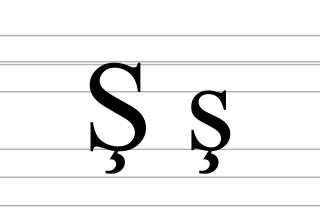
S-cedilla is a letter used in some of the Turkic languages. It occurs in the Azerbaijani, Gagauz, Turkish, and Turkmen alphabets. It is also planned to be in the Latin-based Kazakh alphabet. It is used in Brahui, Chechen, Crimean Tatar, Kurdish, and Tatar as well, when they are written in the Latin alphabet.
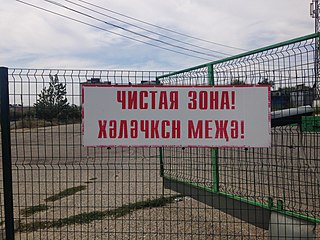
Kalmyk Oirat, commonly known as the Kalmyk language, is a variety of the Mongolian language, natively spoken by the Kalmyk people of Kalmykia, a federal subject of Russia. In Russia, it is the standard form of the Oirat Mongolian, which belongs to the Mongolic language family. The Kalmyk people of the Northwest Caspian Sea of Russia claim descent from the Oirats from Eurasia, who have also historically settled in Mongolia and Northwest China. According to UNESCO, the language is "definitely endangered". According to the Russian census of 2021, there are 110,000 speakers out of an ethnic population consisting of 178,000 people.

Kabardian, also known as East Circassian, is a Northwest Caucasian language, that is considered to be the east dialect of Adyghe language. While some Soviet linguists have treated the two as distinct languages, the Circassians consider the eastern and western language variants to be dialects of one Circassian language.
The European ordering rules define an ordering for strings written in languages that are written with the Latin, Greek and Cyrillic alphabets. The standard covers languages used by the European Union, the European Free Trade Association, and parts of the former Soviet Union. It is a tailoring of the Common Tailorable Template of ISO/IEC 14651. EOR can in turn be tailored for different (European) languages. But in inter-European contexts, EOR can be used without further tailoring.

Bukharian, also known as Judeo-Bukharic and Judeo-Tajik, is a Judeo-Persian dialect historically spoken by the Bukharan Jews of Central Asia. It is a Jewish dialect derived from—and largely mutually intelligible with—the Tajik branch of the Persian language.
Shor, or Kuznets Tatar, is a critically endangered Turkic language spoken by about 2,800 people in a region called Mountain Shoriya, in Kemerovo Oblast in Southwest Siberia, although the entire Shor population in this area is over 12,000 people. Presently, not all ethnic Shors speak Shor and the language suffered a decline from the late 1930s to the early 1980s. During this period the Shor language was neither written nor taught in schools. However, since the 1980s and 1990s there has been a Shor language revival. The language is now taught at the Novokuznetsk branch of the Kemerovo State University.

There are 4 stages in the history of Yakut writing systems:
Cyrillic is a Unicode block containing the characters used to write the most widely used languages with a Cyrillic orthography. The core of the block is based on the ISO 8859-5 standard, with additions for minority languages and historic orthographies.

The I.I. Schmalhausen Institute of Zoology of National Academy of Sciences of Ukraine is the leading institution in Ukraine doing research in zoology. At present, this is the leading regional center of zoological research and expertise in the Eastern Europe.
A phonetic keyboard layout is a setup in which the letters of a language correspond to the keys in the keyboard layout for another language and assumes a one-to-one correspondence between letters in the languages that is based on their sound.
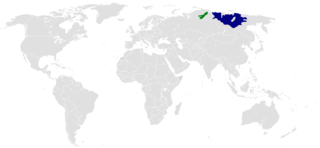
The Dolgan language is a severely endangered Turkic language with 930 speakers, spoken in the Taymyr Peninsula in Russia. The speakers are known as the Dolgans. The word "Dolgan", derived from Evenki, means 'tribe living on the middle reaches of the river'. This is most likely signifying the geographical location of the Dolgan tribe. Its closest relative is Sakha.
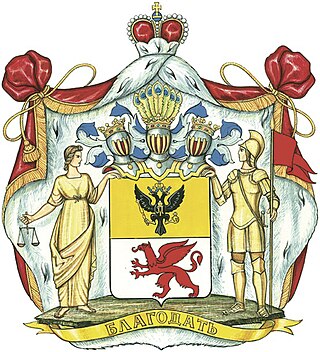
The House of Lopukhin was an old Russian noble family, most influential during the Russian Empire, forming one of the branches of the Sorokoumov-Glebov family.
Cyrillization of German is the conversion of text written in the German Latin alphabet into the Cyrillic alphabet, according to rules based on pronunciation. Because German orthography is largely phonemic, transcription into Cyrillic follows relatively simple rules.
The Komi language, a Uralic language spoken in the north-eastern part of European Russia, has been written in several different alphabets. Currently, Komi writing uses letters from the Cyrillic script. There have been five distinct stages in the history of Komi writing:
Since its inception in the 18th century and up to the present, it is based on the Cyrillic alphabet to write the Udmurt language. Attempts were also made to use the Latin alphabet to write the Udmurt language. In its modern form, the Udmurt alphabet was approved in 1937.
Manifesto to the Ukrainian people with ultimate demands to the Ukrainian Rada is an official document of the Council of People's Commissars of the Russian Soviet Federative Socialist Republic, prepared by Chairman of the Council of People's Commissars Vladimir Lenin, People's Commissar for Foreign Affairs Leon Trotsky, People's Commissar of Nationalities Joseph Stalin.
Khakass alphabets are the alphabets used to write the Khakas language.
Even alphabets are the alphabets used to write the Even language. During its existence, it functioned on different graphic bases and was repeatedly reformed. At present, Even writing functions in Cyrillic. There are three stages in the history of Even writing:
Nivkh alphabets are the alphabets used to write the Nivkh language. During its existence, it functioned on different graphic bases and was reformed several times. Currently, Nivkh writing functions in Cyrillic. There are 3 stages in the history of Nivkh writing:
The Tat alphabet is used for writing in the Tat language, which has two main dialects - the northern one, spoken by Mountain Jews, and the southern one, spoken by the Tats. During its existence, the Tat writing functioned primarily in the northern dialect and at the same time changed its graphic basis several times and was reformed several times. Currently, the writing of the Mountain Jews is in Cyrillic alphabets, and the writing of the Muslim Tats is in the Latin alphabet. There are four stages in the history of Tat writing:
